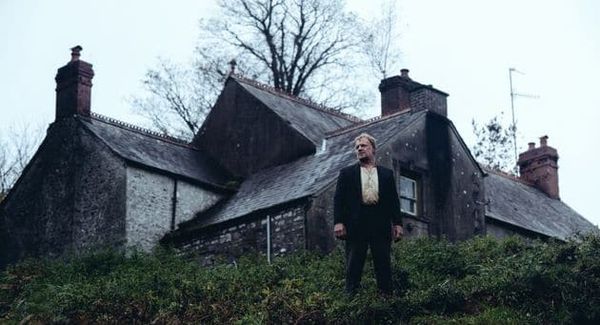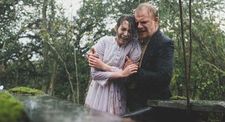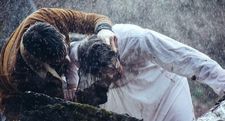 |
| Gareth Bryn: "The house was brilliant. It had to be because it’s really the equivalent of the Psycho house." |
“Everyone puts lot of pressure on a first feature but, you know, you can’t feel that kind of pressure,” says Gareth Bryn, talking about his film, The Passing, which opens in cinemas across the UK on Friday. It’s the story of a young couple rescued from their crashed car by a mysterious stranger who lives alone in an isolated house, and it shows remarkable confidence for a first feature.
Gareth has worked in television for many years, so I start by asking him why he chose this moment to take on cinema.
“I was given the opportunity to create something quite old school that reminded me films like Solaris and the Three Colours trilogy,” he says..” There’s lots of space and lots of silences so as director it was something of a godsend. It gives you lots of license to be creative. Sometimes the script sets out everything so there’s not much room to move but with this I didn’t have that problem.”
It helped that the script was written by someone he knew.
“I’d worked with Ed [Talfan], who wrote it, before. We interned together, so I knew that even if it was not perfect, we could make it work, and together we ironed out many of the issues.”
 |
| Sara and Stanley in The Passing |
Was it difficult getting the finance together for a film that’s entirely in the Welsh language?
“Not at all, because this is part of something called Boom Films that’s financed by S4C. The money was already there for that portion of it. We then added to it from lots of different sources. It worked out well because it meant that there was no big money person sitting at the top saying ‘We want a more commercial film.’ We were given loads of freedom and a lot of the time it was just myself and Ed watching rushes of that day’s scenes in the evening.”
They also had the freedom to pick their own actors.
“I try and cast people as they come,” Gareth says. “When I started in direction I immersed myself in books and tutorials and then somebody told me that the best thing you can do as director is not direct. Just cast it well and then stand back and let it happen, and steer it gently if it goes off track a little. When I watched Mark [Lewes Jones] and Annes [Elwy] audition for Stanley and Sara I was just completely drawn in by them. In fact, when Annes came in for her audition her interpretation was pretty much what ended up in the film.”
The tone of the film is also heavily influenced by the weather, but Gareth tells me that wasn’t as cooperative as might have been expected.
“We had a lot of sunny days unfortunately, which is odd for Wales, so we had to add to it digitally and put digital rain in. It’s quite an analogue film really so it was strange. Some scenes are literally lit by gaslights, but in the end we used quite a lot digital effects. We had a small rain rig with a couple of hoses on the set. It was really the house that we found that needed the most work. I was supposed to be at the bottom of the valley but it was actually the highest thing in the valley, so we painted in all the mountains around it. We filmed them around the area and then painted them in afterwards. The house was brilliant. It had to be because it’s really the equivalent of the Psycho house.
“We had a couple of things forced on us. The house was quite small inside so we had to shoot through doorways and that sort of thing. Also with the lenses, we took vintage Sixties panamorphic lenses and found that they made everything bow a little bit round the edges of the frame. It was distorted, a bit like a fishbowl effect. Richard Stoddard, the director of photography, created this amazing visual language so we had that to fall back on. I don’t like to force an aesthetic. I think it’s better to take elements from what you see around you and let them inform the way you see things, as long as it’s consistent.”
 |
| Under the weather in The Passing |
Water was one of the biggest thematic elements in this film, he adds. It’s not just the rain – it seems omnipresent and, together with the small rooms in the house, contributes to a sense of claustrophobia. He explains how he kept the camera low and how many shots were filmed with a static, handheld camera, contributing to the film’s distinctive look. He valued having the space to determine the pacing of the story for himself and let scenes unfold naturally.
“Lots of people say there’s a big difference between television direction and film direction but for me it’s not the case. The difference is that being given the script gives me the freedom to do my craft, to tell the story differently.”
This was particularly important when it came to hinting at the secret the young couple bring with them, which contributes to the tension long before it’s revealed.
“When you’re watching it you know something’s not right,” he says, which certainly reflects my experience.
Was he worried about how to approach that aspect of the story?
“We just played it straight and saw what came out. In the original draft she had less power. He’s a very dominant character, he has physical power over her, but as we shot it emerged that she has an emotional power over him. It’s something we really pushed in the edit. There’s one scene where he’s fixing the car and she’s leaning on the door frame, and she says ‘Come here and give us a kiss,’ and he say ‘No, you come over here.’ In the original draft she went over to him but in the edit we cut that bit out so she’s still by the door. In that version she’s got more power. He’s quite masculine and forceful but she can have almost an equal power by having that emotional power.”
Given this intense relationship, was he concerned about finding room for Stanley, the man to whom the house belongs?
“The film starts with Stanley but it’s not really his film,” he says. “That’s one of the things I liked about it – it doesn’t fall into traditional structures. We pass the baton from Stanley to Sara. So much of the film is unsaid, too - we know something’s up between the kids but we don’t know Stanley’s motivation or what Stanley might do. With very little action, just the actors standing in a room, the tension keeps building up. We don’t know whether he’s going to kill the kids or the kids are going to kill him. It’s all about the dialogue.”
So how much came together in the edit, and did the final film live up to his expectations?
“I think it’s better than I expected, to be honest, because lots of things came together when we were filming it. Sometimes you just get lucky, like when it was blowing a gale outside during the washing scene, it just really works, or when the sun shines into a lens at just the right moment and it’s absolutely beautiful. There’s the scene with the butterfly that Sara puts out window – that was unrehearsed. Sometimes these things just happen and you feel free with the way you direct things.
"I’m incredibly organised when I’m filming. I absolutely watch the clock, because in television you’ve really got to achieve the day or you get an angry exec on the phone. If you can do that then the compromises you’re making are tiny. Lots of directors start the day as if they’re filming multimillion pound films and then when it gets late and they have to get things finished they end up making compromises all over the place. If you’re in control of the day then when things don’t go your way you’ve got the time to rectify it.”
He recalls how, in one scene, where Sara is recovering from a traumatic experience, having that extra time save the day. “She’s sat on the bed looking out of the window. Initially we shot that as a traditional scene. We shot loads of coverage but it just wasn’t working. I thought, let’s not see her face, let’s have her with her back to us. Then she turns and faces us and lets us in; and we shot that and it worked really well. Because I’d been careful about time management I was allowing myself the time and space to create scenes like that.”
So how does he feel now that the film is heading to cinemas around the UK?
“It’s terrifying,” he says bluntly, then laughs. “With television you do it and you know when it’s going out and people will either watch it or they won’t, but with this you just don’t know what will happen. I’ve been to lots of screenings and I’ve been enjoying the Q&As It’s strange watching your film with lots of people but I’m delighted that it’s getting a release. I love seeing the poster in the foyer.”
Will he be making another film after this, I ask, or going back to television? He assures me it’s the latter.
“Because a film takes so long to get made we’ve got about four or five projects in development at the moment, so who knows which one will happen?”
Does it depend on what happens with The Passing?
“We’ll do it anyway,” he says resolutely. “Even if this is an absolute failure I’m not going to stop making films just because some people don’t like it.”
I assure him that this is a film at least some people are going to love.





















